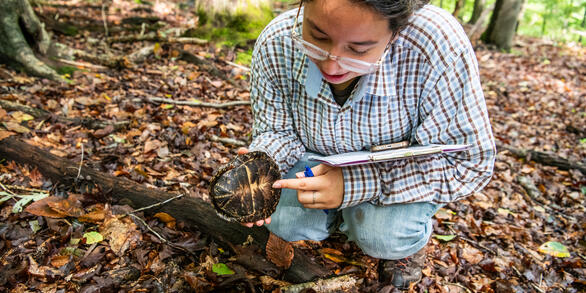Data
At the Eastern Ecological Science Center (EESC), we strive to provide world-class science to inform natural resource decisions that preserve and enhance our quality of life.
Filter Total Items: 300
2022 Release - North American Breeding Bird Survey Dataset (1966-2021) 2022 Release - North American Breeding Bird Survey Dataset (1966-2021)
The 1966-2021 North American Breeding Bird Survey (BBS) dataset contains avian point count data for more than 700 North American bird taxa (species, races, and unidentified species groupings). These data are collected annually during the breeding season, primarily in June, along thousands of randomly established roadside survey routes in the United States and Canada. Routes are roughly...
USGS EcoDrought Stream Discharge, Gage Height, and Water Temperature in Shenandoah National Park, Virginia USGS EcoDrought Stream Discharge, Gage Height, and Water Temperature in Shenandoah National Park, Virginia
The U.S. Geological Survey (USGS) Water Mission Area (WMA) - Ecosystems Mission Area (EMA) EcoDrought project is comprised of interdisciplinary teams in five pilot regions across the country. The over-arching project goal is to measure streamflow in headwater streams and to relate flow variation to stream fish population dynamics. For the catchments located in Shenandoah National Park...
Telemetry data of a Lesser Scaup (Aythya affinis) positive for 2.3.4.4 Highly Pathogenic H5N1 Telemetry data of a Lesser Scaup (Aythya affinis) positive for 2.3.4.4 Highly Pathogenic H5N1
Wild lesser scaup from the Chesapeake Bay, captured and implanted with satellite transmitters for a separate ecology study, were opportunistically sampled for avian influenza. These data detail the virological sampling results, obtained post release, which include a single positive for clade 2.3.4.4 H5N1 virus of the A/goose/Guangdong/1/1996 (Gs/GD) H5N1 lineage of highly pathogenic IAV...
Qualitative value of information for the effects of prescribed fire in Gulf of Mexico marshes: Expert judgment scores from a 2020 adaptive management workshop Qualitative value of information for the effects of prescribed fire in Gulf of Mexico marshes: Expert judgment scores from a 2020 adaptive management workshop
This data set was collected as part of a structured decision-making workshop designed to identify sources of uncertainty and articulate alternative hypotheses about prescribed fire in high marshes of the Gulf of Mexico. Workshop participants independently scored alternative hypotheses based on a standard rubric using an online system. Following the workshop, we used the scores to compute...
Models describing the distribution of chickens, ducks, and geese in China Models describing the distribution of chickens, ducks, and geese in China
This data release provides models detailing previous efforts to understand the distribution of domestic poultry throughout China. These data support a previous USGS publication.
USGS EcoDrought Stream Discharge, Gage Height and Water Temperature Data in Massachusetts (ver. 2.1, August 2025) USGS EcoDrought Stream Discharge, Gage Height and Water Temperature Data in Massachusetts (ver. 2.1, August 2025)
The USGS Water Mission Area (WMA) - Ecosystems Mission Area (EMA) EcoDrought project is comprised of interdisciplinary teams in five pilot regions across the country. The over-arching project goal is to measure streamflow in headwater streams and to relate flow variation to stream fish population dynamics. In the northeast, the New England Water Science Center (NewEngWSC) partnered with...
Species distribution models from a habitat suitability approach: waterfowl of China Species distribution models from a habitat suitability approach: waterfowl of China
This is a data release for models indicating suitable habitat for waterfowl at a 1km resolution across China. Faced with limited data, we built species distribution models using a habitat suitability approach for China's breeding and non-breeding waterfowl. An extensive review of the literature was used to determine model parameters for habitat modeling. Habitat relationships were...
Spatial Models of Wild Bird Risk Factors for Highly Pathogenic A(H5N1) Avian Influenza Virus Transmission Spatial Models of Wild Bird Risk Factors for Highly Pathogenic A(H5N1) Avian Influenza Virus Transmission
Wild waterfowl (family Anatidae) are reported as secondary transmitters of HPAIV and primary reservoirs for low-pathogenic avian influenza viruses, yet spatial inputs for disease risk modeling for this group have been lacking. Using geographic information software and Monte Carlo simulations, we developed geospatial indices of waterfowl abundance at 1 km resolutions for the breeding and...
Water-quality results from a wastewater reuse study: Inorganic and organic compositions of wastewater effluent and select urban and agricultural water types during rain-induced runoff, Chickasha, Oklahoma, 2018-2019 Water-quality results from a wastewater reuse study: Inorganic and organic compositions of wastewater effluent and select urban and agricultural water types during rain-induced runoff, Chickasha, Oklahoma, 2018-2019
Oklahoma State University South-Central Research Station (SCRS) was used to conduct research to understand the chemical composition of various water types and their potential environmental and human health effects. The study area provided the opportunity to study five water types: (1) receiving surface water (Washita River), (2) urban stormwater, (3) wastewater treatment plant effluent...
Population genetic data for three at-risk tiger beetles Habroscelimorpha dorsalis dorsalis, H. d. media, and Ellipsoptera puritana Population genetic data for three at-risk tiger beetles Habroscelimorpha dorsalis dorsalis, H. d. media, and Ellipsoptera puritana
This dataset includes microsatellite genotypes for 16 collections of tiger beetles (Ellipsoptera puritana) distributed in Connecticut and Maryland, United States and 44 collections of Habroscelimorpha dorsalis dorsalis and 14 collections of H. d. media distributed from Massachusetts to Florida, United States.
Salt Marsh Turbidity at Mockhorn Island, VA; Plum Island, MA; York River, VA; and Altamaha River, GA Salt Marsh Turbidity at Mockhorn Island, VA; Plum Island, MA; York River, VA; and Altamaha River, GA
We measured turbidity along transects from channel to marsh interior for 4 sites along the east coast of the United States at: Mockhorn Island, on the Eastern Shore of VA, USA; Plum Island in MA, USA; Goodwin Islands on the York River, VA USA; and the Altamaha River estuary, in GA, USA.
Characterizing microbiota, virulome, and resistome of wild prairie grouse in crop producing and uncultivated areas of Nebraska Characterizing microbiota, virulome, and resistome of wild prairie grouse in crop producing and uncultivated areas of Nebraska
Chart listing the geographic locations, NCBI numbers, voucher numbers, and microbiome characteristics of specimens collected for publication



